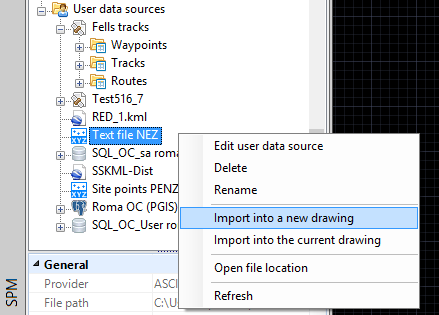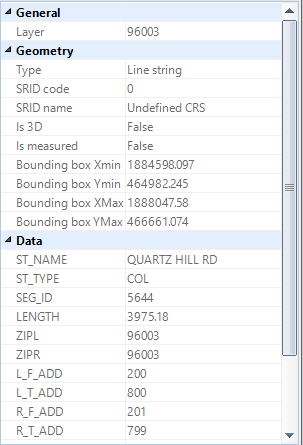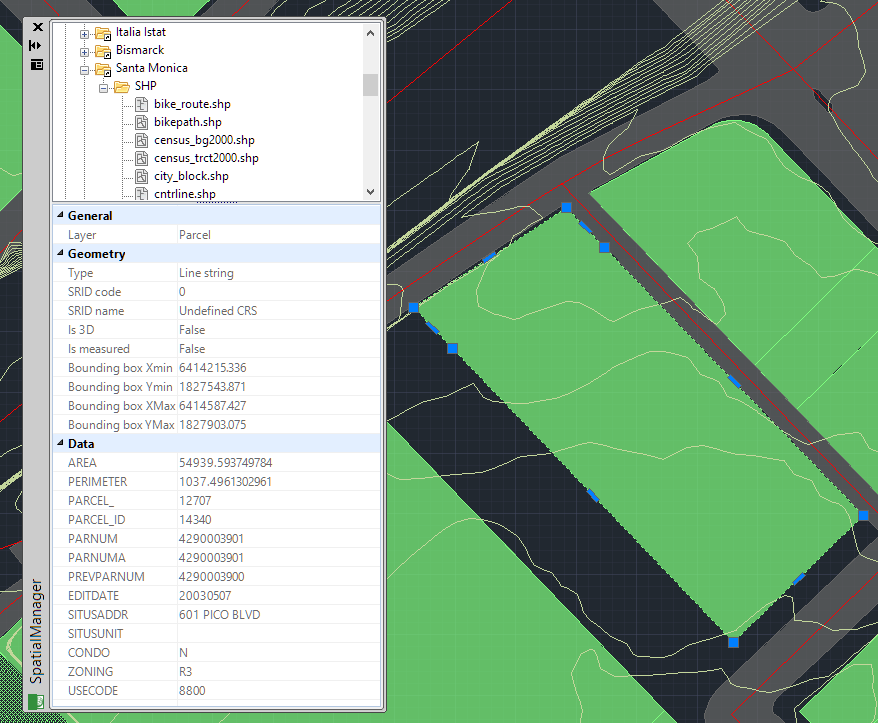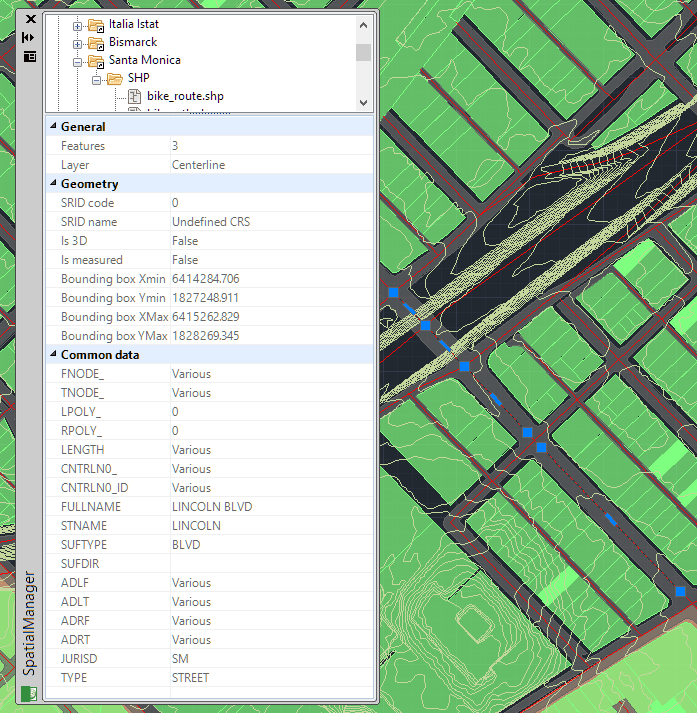Spatial Manager™ for AutoCAD - FAQs: Import
Introduction
- Objective of this section
- To learn how to define import processes and their parameters and manage coordinate transformations
- Topics in this section
- Sources: data sources
- Import parameters: AutoCAD objects parameters, hatches, AutoCAD properties, Extended Entity Data (EED)
- Transforming the coordinates: source and target, favorite coordinate systems, searching in the coordinate systems table and transformation parameters
How can I Import spatial Features as AutoCAD Objects?
You can Import spatial Features as AutoCAD Objects into Spatial Manager™ for AutoCAD by using the contextual menu (mouse right-click) on any table or spatial file in the "Data sources" area of the "SpatialManager" panel. This will launch the "Import" wizard of the application. As you will see, you can import the table or the file in the current or a new drawing.
While running the "Import" wizard, you can select the Import parameters that match your needs:
- Points and Centroids options. Here you can define the options for point type Features and for centroids of Polygons (if you choose any option to draw centroids in the Polygons options). This area will be disabled if the application "knows" there are no points or centroids to draw
- Import as AutoCAD Points
- Import as Blocks. This item will be disabled if there are no Block definitions in the drawing
- Select a Block definition
- Block options. Here you can choose the correspondence between Fields (if any in the data source) and Block Attributes (if any in the Block definition), and the Block Insertion parameters, such as the Rotation and the Scales, from values of Fields in the data source. This item will be disabled if there are no Attributes in the Block definition and there are no numeric Fields in the data source
- Lines and Borders options. Here you can define the options for lineal type Features and for borders of Polygons (if you choose any option to draw borders in the Polygons options). This area will be disabled if the application "knows" there are no lines or borders to draw
- Import as AutoCAD Polylines, Polylines 2D or Polylines 3D
- Insert Nodes (of Polylines) as AutoCAD Points
- Polygons options. Here you can define the options for polygonal type Features. This area will be disabled if the application "knows" there are no polygons to draw
- Import as Borders and/or Centroids
- Fill areas using Hatches. This item will be disabled if you have chosen the option to import as "Only Centroids"
- Hatch options. Here you can define the options for the Hatches such as Pattern, Angle and Scale (except for "Solid" pattern), Apply Transparency to the Hatch (only for "Solid" pattern and whenever AutoCAD supports the Transparency property) and if the Hatch is Associative or not
- AutoCAD Properties
- Destination Layer name. You can select an existing Layer in the drawing or you can write the name to create a new Layer
- Use Field values for destination Layer. Here you can select any Field to define its value as the name of the Layer for the imported Objects. If this value is null for any Object, the Object will be drawn in the Layer selected as "Destination Layer" in the previous item
- Apply random colors to new Layers
- Use Field values for Object Elevation and/or Thickness
- Import Features data as Objects Extended Entity Data (EED). If you choose this option, when you select Objects in the drawing, you will see the Objects EEDs in the "Properties" area of the "SpatialManager" panel
How can I define a Transformation of coordinates?
When you are Importing Features as AutoCAD Objects using Spatial Manager™ for AutoCAD, you will see that you can choose a Transformation of coordinates from the source Features to the objects in the drawing, in the "Import" wizard. That means that the application will calculate a geometric transformation between the source and the target data, which will depend on the chosen CRS for the source (incoming Features) and for the target (imported AutoCAD objects) data. You can choose the appropriate CRSs by clicking on "CRS catalog...", in the CRS dropdown list for the source or for the target data. In the CRS table you can:
- Filter the CRSs by type (Geocentric, Projected, etc.)
- Choose a CRS by clicking on its row in the table
- Search CRSs by typing the search criteria in the "Search" box. You can type here as many words as you like separated by blanks. The application will find all the rows including all these words in a column of the table
After choosing a pair of valid CRS for a Transformation, you must choose the geographic Area to apply it to (the application will choose by default the most common Area for this Transformation)
Note 1: as you will see, the CRS dropdown list will include more and more CRSs as they have been previously chosen in other Transformation operations, so that you can choose your "favorite" CRSs directly from the dropdown list without having to access the CRS Table all the time
Note 2: if the application "knows" the CRS of the source data, it will be chosen by default. You will be able to modify this choice except in cases where only one CRS is valid; for example, for a KML or a KMZ file the only valid choice is the CRS WGS84 (SRID 4326), because these types of file are always defined using this CRS
Can I see the data of the imported Features?
Yes, you can see the data of the imported Features in Spatial Manager™ for AutoCAD, because this data is also imported as EED (Extended Entity Data) attached to the resulting Objects in the drawing. To see it, select an imported Object in AutoCAD and its data will be shown in the group "Data" of the "Properties" area in the "SpatialManager" panel
In addition to the EED, you will see some other Object data, such as its Layer or its Bounding box, in other groups, such as "General" or "Geometry"
When selecting multiple Objects, you will see their common data here. All the data which is not equal for the selection, will be shown as "Various"
Related links
- See "Providers" also
- Blog posts
- Technical pages



